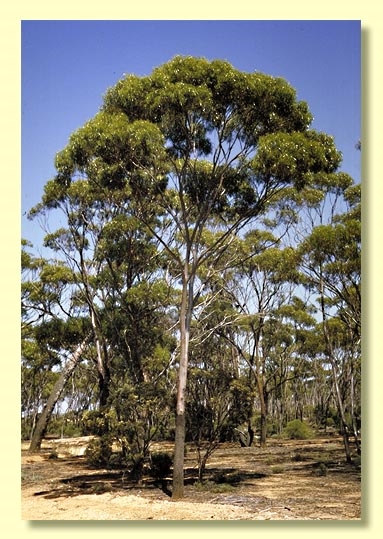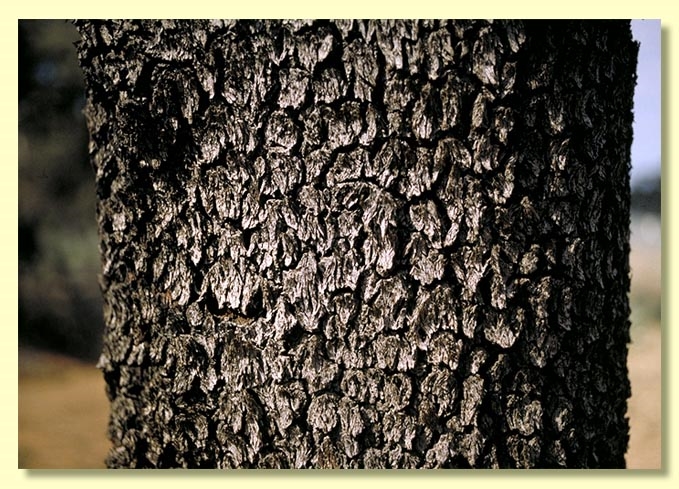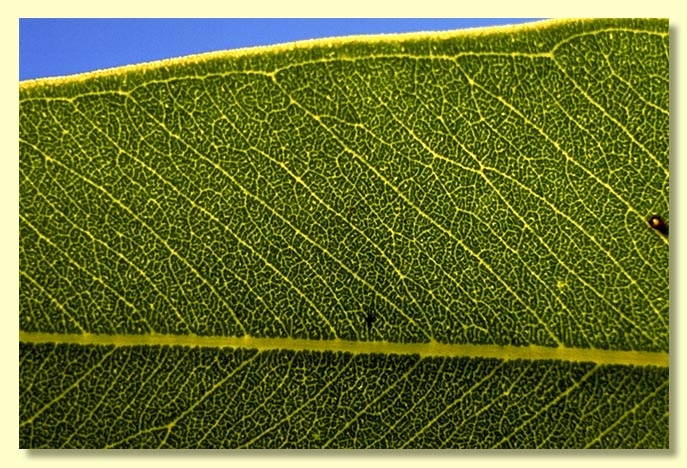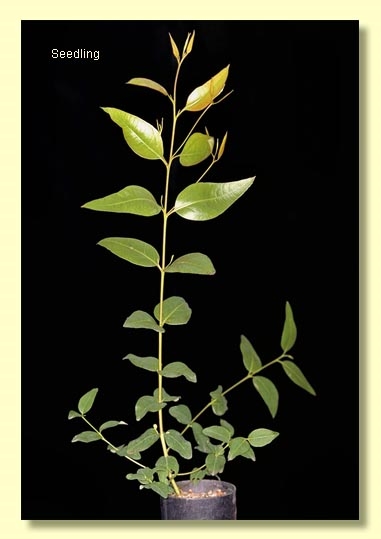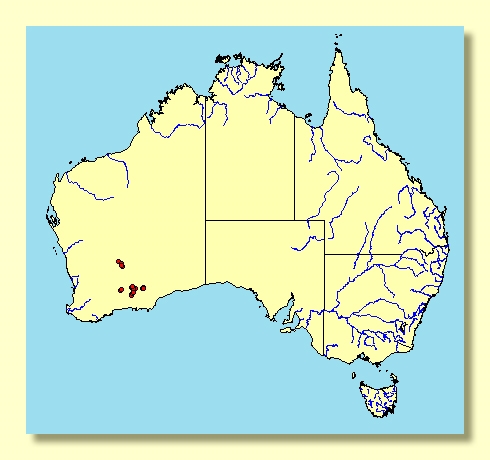Euclid - Online edition
Eucalyptus dundasii
Eucalyptus | Symphyomyrtus | Bisectae | Glandulosae | Dundasianae
T: Dundas, W.A., 1901, L.Diels 5454; holo: NSW.
Bark rough, tightly held, blackish, scaly or tessellated for 2–3 m or more of trunk, then smooth blackish grey-green over coppery.
Branchlets glaucous only in some northern populations, pith oil glands always present.
Juvenile growth (coppice or field seedlings to 50 cm): stems rounded in cross-section; juvenile leaves always petiolate, opposite for ca 2 nodes then alternate, broadly lanceolate, 6.5–11 cm long, 3–4.5 cm wide, glossy, green, discolorous until well into sapling stage but ultimately concolorous.
Adult leaves alternate, petioles 0.8–1.8 cm long; blade narrowly lanceolate to falcate, 6–12(13.5) cm long, 0.6–1.7 cm wide, base tapering to petiole, margin entire, apex pointed, very glossy, green, side-veins greater than 45° to midrib, reticulation dense to very dense, intramarginal vein close to margin and may be absent at times, oil glands apparently absent or obscure.
Inflorescence axillary unbranched, peduncles 0.6–1.6 cm long, buds 7 per umbel, sessile to shortly pedicellate (pedicels 0–0.1 cm long). Mature buds more or less cylindrical but hypanthium slightly contracted below the join, 0.7–1.1 cm long, 0.3–0.4 cm wide, smooth or slightly ribbed basally, scar present, operculum beaked, stamens completely inflexed, anthers oblong, versatile, dorsifixed, dehiscing by longitudinal slits, filaments glandular, style long and straight, stigma blunt to tapered, locules 3, the placentae each with 4 vertical rows of ovules. Flowers creamy white.
Fruit usually sessile, rarely shortly pedicellate (pedicels 0–0.2 cm long), cylindrical to narrowly urceolate, 0.6–0.9 cm long, 0.4–0.6 cm wide, smooth or scarcely ribbed basally, disc descending vertically, valves 3, enclosed.
Seeds mid-brown, 1–2 mm long, ovoid, dorsal surface clearly but shallowly reticulate, hilum ventral.
Cultivated seedlings (measured at ca node 10): cotyledons Y-shaped (bisected); stems rounded in cross-section; leaves opposite and shortly petiolate for 6 to 10 nodes then alternate and with longer petioles, ovate to lanceolate, 7–10 cm long, 2–4.5 cm wide, dark green, dull until ca node 6 then glossy, discolorous until ca node 10 then concolorous.
Flowering has been recorded in January and May.
E. dundasii has been used for mining timbers as the wood is durable. Also grown for shade and as an ornamental in arid zone plantings.
A small to medium-sized tree endemic to Western Australia, occurring in two disjunct areas, the principal distribution being the southern goldfields around Norseman and the other site being north of Coolgardie, near Callion. The trunk is distinctive in the blackish, thick, tessellated rough bark on the lower half. The adult leaves are very glossy, green with oil glands obscure or absent. Trees in the Callion area have glaucous branchlets.
Eucalyptus dundasii belongs in Eucalyptus subgenus Symphyomyrtus section Bisectae subsection Glandulosae because the buds have an operculum scar, cotyledons are bisected and branchlets have oil glands in the pith. Within this large subsection (ca 80 species) E. dundasii has no close relatives and forms the monotypic series Dundasianae. It is distinctive because of its bark and leaf characteristics and also the completely inflexed stamens and reticulate flattened-ovoid seed.

